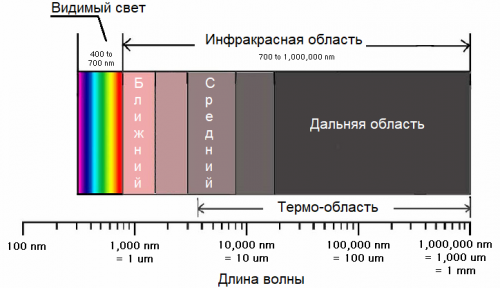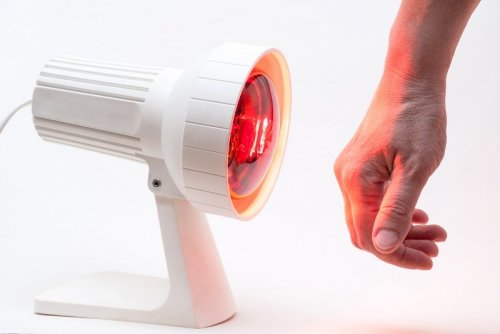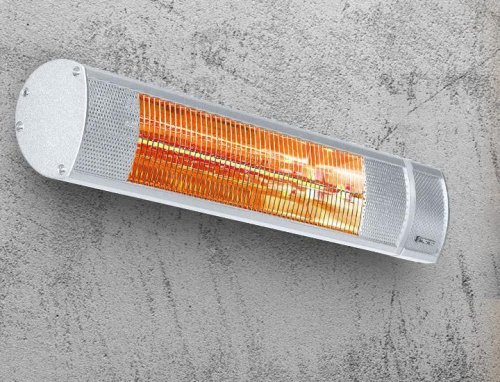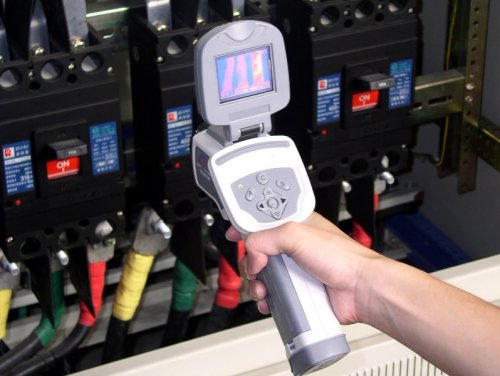Infrared radiation and its applications
Electromagnetic radiation with a wavelength of 0.74 microns to 2 mm is called in physics infrared radiation or infrared rays, abbreviated «IR». It occupies that part of the electromagnetic spectrum that lies between visible optical radiation (originating in the red region) and the short-wave radio frequency range.
Although infrared radiation is practically not perceived by the human eye as light and does not have any specific color, it nevertheless belongs to optical radiation and is widely used in modern technology.
Infrared waves, which are characteristic, heat the surfaces of bodies, which is why infrared radiation is also often called thermal radiation. The entire infrared region is conditionally divided into three parts:
-
far infrared region — with wavelengths from 50 to 2000 microns;
-
mid-IR region — with wavelengths from 2.5 to 50 microns;
-
near infrared region — from 0.74 to 2.5 microns.
Infrared radiation was discovered in the 1800s.by the English astronomer William Herschel, and later, in 1802, independently by the English scientist William Wollaston.
IR spectra
Atomic spectra obtained in the form of infrared rays are linear; condensed matter spectra — continuous; molecular spectra are banded. The conclusion is that for infrared rays, compared to the visible and ultraviolet regions of the electromagnetic spectrum, the optical properties of substances, such as the coefficient of reflection, transmission, refraction, are very different.
Many of the substances, although they transmit visible light, turn out to be opaque to waves in part of the infrared range.
For example, a layer of water several centimeters thick is opaque to infrared waves longer than 1 micron, and under some conditions can be used as a thermal protection filter. And the layers of germanium or silicon do not transmit visible light, but transmit infrared rays of a certain wavelength well. Far infrared rays are easily transmitted by black paper and can serve as a filter for their isolation.
Most metals, such as aluminum, gold, silver and copper, reflect infrared radiation with a longer wavelength, for example, at an infrared wavelength of 10 microns, the reflection from metals reaches 98%. Solids and liquids of a non-metallic nature reflect only part of the IR range, depending on the chemical composition of a particular substance. Due to these features of the interaction of infrared rays with various media, they are successfully used in many studies.
Infrared scattering
Infrared waves emitted by the Sun passing through the Earth's atmosphere are partially scattered and attenuated by air molecules and atoms. Oxygen and nitrogen in the atmosphere partially weaken infrared rays, scattering them, but do not completely absorb them, since they absorb part of the rays of the visible spectrum.
Water, carbon dioxide, and ozone contained in the atmosphere partially absorb infrared rays, and water absorbs them the most because its infrared absorption spectra fall over the entire region of the infrared spectrum, and the absorption spectra of carbon dioxide fall only in the middle region .
The layers of the atmosphere near the Earth's surface transmit very little of the infrared radiation, as smoke, dust and water further attenuate it, scattering the energy onto their particles. The smaller the particles (smoke, dust, water, etc.) , the less IR scattering and more visible wavelength scattering. This effect is used in infrared photography.
Sources of infrared radiation
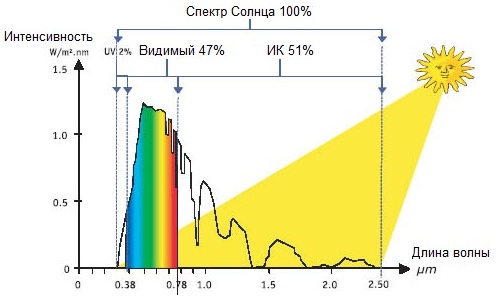
For us living on Earth, the Sun is a very powerful natural source of infrared radiation because half of its electromagnetic spectrum is in the infrared range. Incandescent lamps, the infrared spectrum is up to 80% of the radiation energy.
Also, artificial sources of infrared radiation include: electric arc, gas discharge lamps and, of course, household heaters of heating elements.In science, to obtain infrared waves, the Nernst pin, tungsten filaments, as well as high-pressure mercury lamps and even special IR lasers are used (neodymium glass gives a wavelength of 1.06 microns, and a helium-neon laser - 1.15 and 3.39 microns, carbon dioxide — 10.6 microns).
IR receivers
The principle of operation of infrared wave receivers is based on the conversion of the energy of the incident radiation into other forms of energy available for measurement and use. The infrared radiation absorbed in the receiver heats the thermosensitive element and a rise in temperature is recorded.
Photoelectric IR receivers generate electrical voltage and current in response to a specific narrow part of the IR spectrum for which they are designed to operate, that is, IR photoelectric receivers are selective. For IR waves in the range up to 1.2 μm, photographic registration is carried out using special photographic emulsions.
Infrared radiation is widely used in science and technology, especially for solving practical research problems. The absorption and emission spectra of molecules and solids that just fall into the infrared region are studied.
This approach to research is called infrared spectroscopy, which allows solving structural problems by performing quantitative and qualitative spectral analysis. The far infrared region contains emissions caused by transitions between atomic subplanes. Thanks to IR spectra, you can study the structures of the electron shells of atoms.
And this is not to mention photography, when the same object photographed first in the visible and then in the infrared range will look different, because due to the difference in transmission, scattering and reflection for different areas of the electromagnetic spectrum, some elements and details in an unusual photo shooting mode may be completely missing: in an ordinary photo, something will be missing, and in an infrared photo it will become visible.
The industrial and consumer uses of infrared radiation cannot be underestimated. It is used for drying and heating various products and materials in industry. In houses, the premises are heated.
Electro-optical transducers use photocathodes that are sensitive in the infrared region of the electromagnetic spectrum, allowing you to see what is invisible to the naked eye.
Night vision devices allow you to see in the dark due to the irradiation of objects with infrared rays, infrared binoculars - for night observation, infrared sights - for aiming in complete darkness, etc. By the way, with the help of infrared radiation, you can reproduce the exact meter standard.
Highly sensitive receivers of IR waves allow determining the direction of various objects by their thermal radiation, for example, missile guidance systems work, which additionally generate their own IR radiation.
Rangefinders and locators based on infrared rays allow to observe some objects in the dark and measure the distance to them with high accuracy. IR lasers are used in scientific research, for probing the atmosphere, for space communications, and more.

